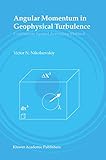Angular momentum in geophysical turbulence continuum spatial averaging method Libro electrónico Victor N. Nikolaevskiy
Tipo de material: Libro
en línea Idioma: Inglés Detalles de publicación: Dordrecht Springer science c2003Descripción: ix, 245 páginas gráf., mapas centímetrosISBN:
Libro
en línea Idioma: Inglés Detalles de publicación: Dordrecht Springer science c2003Descripción: ix, 245 páginas gráf., mapas centímetrosISBN: - 9048164788
- 9789048164783
- 9789401701990 (Online)
- Disponible en línea
Incluye bibliografía: páginas 221-240 e índice: páginas 41-245
Disponible para usuarios de ECOSUR con su clave de acceso
Turbulence theory is one of the most intriguing parts of fluid mechanics and many outstanding scientists have tried to apply their knowledge to the development of the theory and to offer useful recommendations for solution of some practical problems. In this monograph the author attempts to integrate many specific approaches into the unified theory. The basic premise is the simple idea that a small eddy, that is an element of turbulent meso-structure, possesses its own dynamics as an object rotating with its own spin velocity and obeying the Newton dynamics of a finite body. A number of such eddies fills a coordinate cell, and the angular momentum balance has to be formulated for this spatial cell. If the cell coincides with a finite difference element at a numerical calculation and if the external length scale is large, this elementary volume can be considered as a differential one and a continuum parameterization has to be used. Nontrivial angular balance is a consequence of the asymmetrical Reynolds stress action at the oriented sides of an elementary volume. At first glance, the averaged dyad of velocity components is symmetrical, == However, if averaging is performed over the plane with normal nj, the principle of commutation is lost. As a result, the stress tensor asymmetry j is determined by other factors that participate in the angular momentum balance. This is the only possibility to determine a stress in engineering." Inglés
Disponible en línea
Disponible en formato PDF


